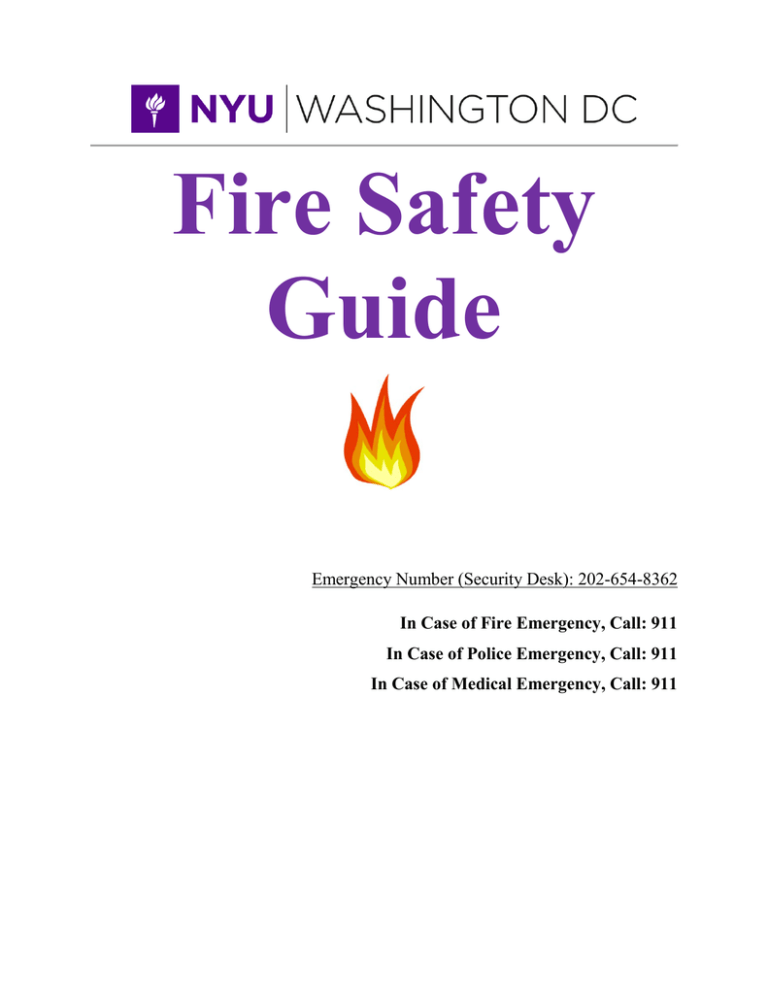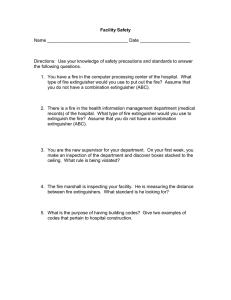Emergency Number (Security Desk): 202-654
advertisement

Fire Safety Guide Emergency Number (Security Desk): 202-654-8362 In Case of Fire Emergency, Call: 911 In Case of Police Emergency, Call: 911 In Case of Medical Emergency, Call: 911 New York University Global Fire Safety Guide Table of Contents Introduction 2 Fire Alarm Policy 2 General Fire Emergency Instructions 2 No Smoking Policy 4 Prevention of Fires 5 Automatic Fire Sprinklers 6 Portable Fire Extinguishers 6 Pull-out RACE poster 7 This Fire Safety Guide was prepared by: New York University Environmental Health and Safety 10 Astor Place New York, NY 10003 July 2015 Edition 1 New York University Global Fire Safety Guide Introduction This fire safety guide has been developed by NYU Environmental Health and Safety, in conjunction with NYU’s global sites, in order to provide students studying away with a guide on how best to respond to a fire emergency, taking into account the wide array of facilities that the University leases and operates, as well as local laws and regulations. Should you have any questions or concerns about best practices in case of a fire emergency, please contact NYU Environmental Health and Safety, at +1.212.998.1450 or EHS-fire@nyu.edu, or Caroline Klein at your site (c.klein@nyu.edu). Fire Alarm Policy It is the policy of the University that when smoke or fire is discovered, the fire alarm, if present, must be activated. Because of the potential for underestimating the seriousness of a fire condition, there are no exceptions to this policy. If a smoke alarm sounds in an individual apartment due to the smoke detector going off, residents are instructed to contact security and/or the duty phone for further assistance. If there is a fire that residents are unable to address with a fire extinguisher, residents MUST evacuate the building pulling the fire alarm at the nearest station. When the building fire alarm sounds every student, faculty, and staff member is expected to immediately follow the emergency procedures for their facility. Fire alarms systems vary throughout the global network. You should be familiar with the system type in the building(s) that you live and study in. There is no way of knowing if an alarm signifies a drill or an actual fire emergency; therefore, every alarm must be treated as a potentially serious fire. Fire Drill Information The University’s global sites conduct fire drills throughout the year. Since fire drills are not announced, every fire alarm should be treated as an emergency and all building occupants must follow their facility’s emergency procedures. General Fire Emergency Instructions Learn the Egress Routes ● Become familiar with the routes of egress before an emergency occurs. ● Make sure that you are familiar with the evacuation procedures and what is expected when there is a fire and the alarm is activated. ● Ensure that the routes of egress are free of all obstructions. Nothing should be stored in stairwells or obstructing the path of travel through hallways. If you do observe something blocking the path of egress, speak to your RLA or another staff member and ask that it be removed immediately. ● Fire doors, where present, should be kept closed at all times and never propped open. 2 New York University Global Fire Safety Guide If You Suspect or Discover a Fire ● Do not attempt to fight the fire unless it is necessary for your escape ● Activate the fire alarm if you building is equipped with manual pull stations or call points by following the instructions on the device. This may include calling the fire department from a safe location. ● See sheet on R.A.C.E. at the end of this guide. ● Call the appropriate emergency number for your facility - from a safe location ● Know the emergency numbers at your facility; it is suggested that you save them in your phone for quick access in an emergency. ● Public safety personnel should be notified of the location of the smoke or fire condition, including the building, floor and/or room number and the name and telephone number of the individual reporting the incident. Evacuate ● Upon hearing the building fire alarm, all occupants must exit the building using the nearest safe means of egress. ● Close all doors and windows to prevent the spread of fire and smoke. Leave lights on. ● Never use an elevator during a fire alarm activation. ● Keep low to the floor to avoid smoke and toxic gases. ● Once in the stairway, proceed down to the first floor and exit the building. ● Move away from the building, and out of the way of firefighters and other emergency personnel. ● Do not attempt to re-enter the building for any reason, until you are authorized to do so. ● You are requested to assist persons with disabilities. The person should either remain in their room or be relocated to a designated area of rescue assistance preferably a room with an exterior window and a telephone. The public safety emergency number should be called immediately to advise of the exact location of the person(s). If a telephone is not readily available, someone should go to the building entrance and notify the public safety official of the exact location of the person(s). The public safety official will inform the emergency responders of the location and the emergency responders will determine if an evacuation is warranted. If You are Trapped ● Don’t Panic! ● If a telephone is available, call the appropriate emergency number for your facility. ● Keep doors closed. Do not attempt to open a door without first feeling with the back of your hand. If the door is hot, try another exit. If no other exit is available, seal openings into the area with available materials, such as wet towels. ● Signal firefighters from a window if possible. ● Stay close to the floor. If fresh air is needed open the window slightly at the bottom. ● Remain by the window until the fire department arrives. 3 New York University Global Fire Safety Guide If Your Clothing Catches Fire ● ● ● ● ● Don’t Panic! Stop where you are. Drop to the ground and cover your face with your hands. Roll around until the flames are extinguished. Seek immediate medical attention. Smoking Policy NO SMOKING Follow all policies for your facility regarding if and where smoking is permitted. 4 New York University Global Fire Safety Guide Prevention of Fires ● Keep your living space free of trash; empty all trash containers daily. Electrical Fire Safety: ● Never overload wall outlets. One outlet should have no more than two plugs. ● Never overload surge protectors or connect surge protectors in series; each surge protector should be plugged directly into an outlet. ● Always use rated surge protectors with circuit breaker protection, not power strips (Please note, it is important to check the information on a product when you purchase it). ● Do not use extension cords as permanent wiring. ● Check electrical equipment for old, worn, or damaged wiring or broken or damaged fittings. ● Investigate any appliance or electrical equipment that smells strange. Unusual odors can be the first sign of fire. Cooking Fire Safety ● ● ● ● Do not leave cooking unattended, for any amount of time. Do not use water on grease fires, instead slide a pot lid over the burning pot. Do not tamper with smoke detectors. Follow all of the cooking instructions that are provided with the food and equipment. Prohibited Items ● ● ● ● ● ● ● ● ● ● Non-University issued furniture Halogen lamps Candles or incense Hot plates Electric heaters or air conditioners Outdoor grills Any type of open flame or coil device Storage of flammable liquids Natural or artificial evergreens Explosives, fireworks, firearms, or ammunition 5 New York University Global Fire Safety Guide Automatic Fire Sprinklers If your facility has fire sprinklers, there are some general practices that should be observed. Fire sprinklers should be kept clear of obstructions. Always maintain at least 18 inches (45 cm) of clearance of all objects from the sprinkler to ensure proper operation of the sprinkler in an emergency. Objects should never be attached to or hung from sprinklers, as this impairs the function of the sprinkler and can result in an unintentional activation, which will cause severe flooding. Portable Fire Extinguishers If your facility provides fire extinguishers you should become familiar with these before an emergency occurs. Every portable fire extinguisher displays the rating on the faceplate indicating the class of fire that it is designed to be effective on. Operating a Portable Fire Extinguisher A portable fire extinguisher should only be used in the early stages of a fire and only when it is safe to do so. If the fire is too large, or it is spreading and threatening to block your path of escape, leave the area immediately. If necessary, do not hesitate to use the extinguisher to clear an escape path. Always fight a fire with your back to your escape route. In an emergency situation you should know how to use an extinguisher properly. Become familiar with how to use the extinguishers at your facility before a fire occurs. Important: Follow the instructions on the fire extinguisher and make sure it is the correct extinguisher for the material that is burning; if you are not sure, evacuate immediately. Never fight a fire alone – If you must use a fire extinguisher to secure safe exit from the building, use the PASS method. PULL, AIM, SQUEEZE, SWEEP. P - Pull the pin A - Aim the extinguisher at the base of the flames S - Squeeze the trigger while holding the extinguisher upright S - Sweep the extinguisher from side to side, covering the area of the fire with extinguishing agent 6 New York University Global Fire Safety Guide 7


